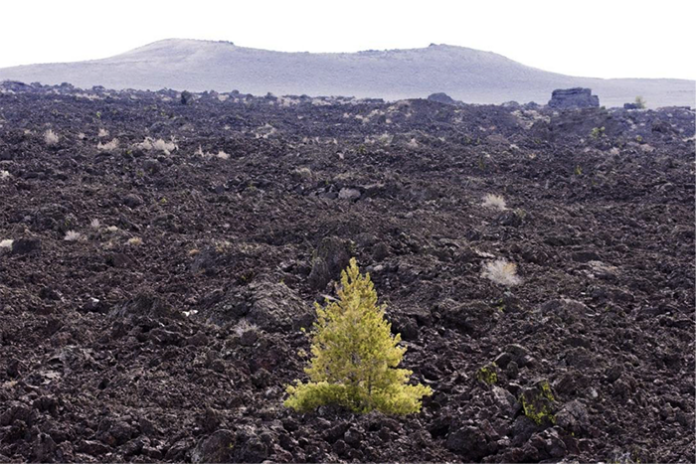
BY LARRY BARNES
The 155 million acres of shrub-steppe habitat that spreads across Western North America has mostly been degraded by fragmentation (i.e., roads), alien weeds, agriculture, changing fire ecology, drought, and livestock grazing. What was it like before the cataclysmic changes ignited by the arrival of Columbus? There are windows into the past, albeit scratched and dingy ones, that reveal the shrub-steppe ecosystem’s former character and glory.
Kipuka is a Hawaiian word for window that is used to describe a plant community island that is surrounded by a lava flow. As lava pours downslope from a volcano, incinerating everything in its path, it sometimes parts around a high point on the land, then rejoins downslope, leaving an island of life surrounded by a sterile sea of cooling lava. In Hawaii, kipukas may be forest patches; here in Idaho, kipukas are fragments of the sagebrush sea.
By entering a kipuka one steps into a land that cattle, sheep, and horses forgot. For example, the Carey Kipuka in the northwest portion of Craters of the Moon National Monument is encircled by a malevolent jumble of sharp-edged, loose, ankle-breaking rock known as a’a lava. About 6,600 years ago, a lava flow cooled and slowed as it moved downslope around a high point that would become the Carey Kipuka. The cooling lava slowed and thickened while being forcefully pushed by upstream hotter lava, creating today’s confused nightmare of basaltic rock. To visit this kipuka, you must tediously pick your way almost a mile across untrustworthy, shaky ground.
There are about 580 kipukas in the Craters of the Moon, and the largest, Laidlaw Park, is 84,400 acres. Many others are only an acre. But the big kipukas are largely broken now as the grass within them was deemed too valuable to ignore and bulldozers punctured their sanctity to build roads for the safe passage of sheep and cattle. The Carey Kipuka’s modest 170 acres, however, has spared it from the blade and it remains an example of virgin sagebrush-steppe – sort of.
As I picked my way across the “black vomit,” as pioneer Julius Merrill described it in 1864, toward the Carey Kipuka, I wondered if even deer and pronghorn were excluded from this little patch of steppe habitat. Finally reaching firm ground from the farrago of lava, I soon encountered deer tracks and scat. I saw no easy route in or out and wondered if a path of firm snow sometimes allowed access for deer to obey optimal forage strategy and visit the kipuka to browse where competition with other ungulates was low.
Even these protected kipukas have not entirely dodged the post-Columbus transformation of the shrub-steppe. Alien cheatgrass has taken over much of the West and the kipukas have not been spared. Crested wheatgrass, another alien plant, occurs in some kipukas. But kipukas are less weedy than the surrounding lands that have been grazed by livestock for a century and kipukas often have higher plant diversity and healthier soils.
When I visited the Carey Kipuka, the season was early and most annual plants were still in the ground. I found a single flake of obsidian on a high point and imagined a Shoshone Indian working an arrowhead where I stood, the same snowy mountains to the north and the same tricky route through lava to get here. But the flake may have been dropped there more than 6,600 years ago when the land was contiguous to a weed-free North America — a continent-sized kipuka before the advancing lava-like influence that came on the heels of Christopher Columbus.
Larry Barnes retired from 26 years as a biology teacher at Wood River High School and is now transitioning to spending more time exploring the natural world.
